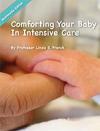
Empowering Parents to Help Their Babies in the Neonatal Intensive Care Unit
It’s common for new parents to be nervous and uncertain about how to soothe a crying baby. In those first days, a little support can go a long way toward reassuring parents that they’re more than capable of caring for their child, even in stressful moments, like getting the first immunizations.
Parents of babies born early or sick, who may need to undergo painful procedures – and may be too weak even to cry – have additional worries and need even more support and guidance in learning to do this most basic of parenting tasks: comforting their baby.
 Linda Franck With a website, a booklet and, now, an enhanced multimedia booklet – Comforting Your Baby in Intensive Care – Linda Franck, chair of the Department of Family Health Care Nursing at UC San Francisco School of Nursing, is working tirelessly to help parents understand how best to comfort their babies during their stay in the neonatal intensive care unit (NICU) and after they go home.
Linda Franck With a website, a booklet and, now, an enhanced multimedia booklet – Comforting Your Baby in Intensive Care – Linda Franck, chair of the Department of Family Health Care Nursing at UC San Francisco School of Nursing, is working tirelessly to help parents understand how best to comfort their babies during their stay in the neonatal intensive care unit (NICU) and after they go home.
The booklet evolved from the observations Franck made while studying pain management in children and infants over several years. She consistently found that parents craved information about how they could be more involved in their baby’s care – especially in comforting their baby. As one parent told her, “All I want to do is to be able to comfort my baby when needed.… How can you comfort a baby when you can’t hold them due to the fact that they are in an incubator, wired up to different monitors and breathing equipment?”
Franck wanted to give parents the information they needed to help them be as involved as they wanted to be, but there were few resources. “Until now, there hasn’t been any written resource specifically for parents of babies cared for in the NICU,” she says.
She and her colleagues developed materials and tested them in a number of NICUs in England and the US. With funding from the School, the March of Dimes and Bliss (a UK charity for premature and ill infants) and in collaboration with UCSF Benioff Children’s Hospital San Francisco, Franck has now turned the materials into a multimedia booklet that draws on her research and on the experience of numerous professionals and families.
 The booklet guides parents through techniques they can use to minimize infants’ stress and discomfort. These include creating a calming environment by reducing exposure to bright lights or loud noises, and providing comforting touch and oral comfort, such as breastfeeding. The booklet also explains essential facts about pain in babies and teaches parents how to recognize it. It explains how NICU nurses and doctors monitor and treat infant pain, and the special role that parents play as part of their baby’s comfort team. Throughout, it encourages parents to take a proactive stance in comforting and advocating for their child, including asking questions and speaking up if they notice that the comfort plan isn’t working.
The booklet guides parents through techniques they can use to minimize infants’ stress and discomfort. These include creating a calming environment by reducing exposure to bright lights or loud noises, and providing comforting touch and oral comfort, such as breastfeeding. The booklet also explains essential facts about pain in babies and teaches parents how to recognize it. It explains how NICU nurses and doctors monitor and treat infant pain, and the special role that parents play as part of their baby’s comfort team. Throughout, it encourages parents to take a proactive stance in comforting and advocating for their child, including asking questions and speaking up if they notice that the comfort plan isn’t working.
Hyperlinks embedded in the online booklet lead the viewer to video clips that provide real-life demonstrations of parents using the techniques with their babies in the NICU. There is a full-text audio track as well. “We wanted to make it more engaging and accessible so parents have the option to read, watch or listen – or all three,” says Franck.
In testing the materials, Franck found that while the information did not reduce parents’ feelings of stress related to having a sick baby in the NICU, those who received the written materials were highly satisfied with the information and felt they were more involved in comforting their babies compared with a group of parents who received only standard verbal and written information about the NICU. When they went home, parents who had received the booklet felt more confident and competent in understanding their baby’s stress cues and in comforting their baby. Franck said parenting confidence at home is especially important, because parents don’t have the NICU nurses to turn to for guidance: “It’s a really vulnerable time for them.”
Moreover, in the NICUs that used the booklet, nurses documented doing more pain assessments for the babies. Franck says, “Nurses told me they liked having it to prompt and guide the conversations with parents about what was being done for the baby’s pain management.”
Franck plans to continue refining the booklet, based on feedback from parents and NICU clinicians who complete the online survey at the end of it. It’s currently available in English and Spanish as a free download for iPad or Mac (from the iBooks app) or as a PDF (from the booklet website) that can be viewed on other devices. The website also has downloadable flyers (in English and Spanish) with instructions for downloading the booklet; these flyers can be posted in the NICU, where parents will see them. Scanning a QR code on the flyer will take users directly to the booklet website.
Says Franck, “Parents need to know that they have a very important role in their baby’s comfort. Over time, parents will get to know their baby better than anyone else.”



